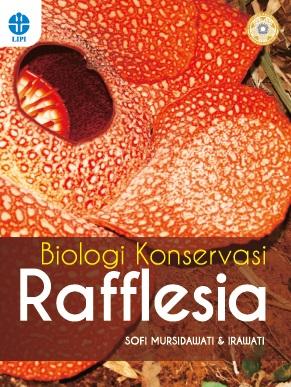Biologi Konservasi Rafflesia
Keywords:
Biologi, Konservasi, RafflesiaSynopsis
Pelestarian Rafflesia sebagai puspa langka dan tumbuhan khas Indonesia perlu terus dibangun dan digalakkan oleh seluruh masyarakat. LIPI patut berbangga hati atas keberhasilan Kebun Raya LIPI Bogor dalam mengonservasi habitat Rafflesia, melestarikan, dan memperluas kehidupan populasinya di alam. Kupas dan telisik (kulik) lebih cermat semua informasi terkait puspa langka dan pelestariannya. Temukan ciri keunikan puspa langka ini, baik sifat biologisnya, morfologi buah dan bijinya, maupun upaya menumbuhkan Rafflesia pada media kultur jaringan. Mari memulai aksi nyata melindungi kelestarian Rafflesia dengan memperkaya informasi dan pengetahuan dengan membaca buku ini. Kemudian kuatkan niat dengan bergabung dengan forum yang akan melaksanakan Strategi Rencana Aksi Konservasi (SRAK) Rafflesia. Semoga catatan keberhasilan dalam buku ini dapat menginspirasi masyarakat untuk menjaga dan mencintai puspa langka ini. Dirgahayu Kebun Raya LIPI, Bogor!
Downloads
References
Arditti, J. & Ghani, A.K.A. (2000). Tansley Review No. 110. Numerical and Physiological Property of Orchid Seeds and their Biological Implica- tions. New Phytologist, 145, 367–421.
Astuti, I. P., Yuzammi, Darnaedi, D. (2001). Usaha konservasi ex-situ jenis-jenis Ra esia di Kebun Raya Bogor. Dalam Prosiding Seminar Nasional Puspa Langka Indonesia–Bogor: Ra esia Foundation, 28–30.
Ba?nziger, H. (1995). Ecological, morphological and taxonomic studies on Thailand’s fth species of Ra esiaceae: Rhizanthes zippelii (Blume) Spach. The Natural History Bulletin of the Siam Society, 43(2), 337–365.
Ba?nziger. H. (2004). Studies on hitherto unknown fruit and seeds of some Ra e- siaceae and unknown method to manually pollinate their owers for research and conservation. Linzer Biol. Beitr., 36(2), 1175–1198.
Ba?nziger. H., Lamb. A., & Kocyan, A. (2007). Bisexual Rhizanthes lowii (Beccarii) Harms (Ra esiaceae) from Borneo: First description of owers, fruits and seeds. Natural History Bulletin Siam Society, 55(2), 341–352.
Barcelona, J. F., Pelser, P. B., Balete, D. S., & Co, L. L. (2009). Taxonomy, ecology, and conservation status of Philippine Rafflesia (Rafflesiaceae). Blumea, 54, 77–93.
Baskin, C. C. & Baskin, J. M. (2004). Determining dormancy-breaking and germina- tion requirements from the fewest seeds. Dalam E.O. Guerrant Jr., K. Havens, dan M. Maunder. Ex Situ Plant Conservation Supporting Species Survival in the Wild. Washington: Island Press. Society for Ecological Restoration International Center for Plant Conservation.
Beaman, R. S., Decker, P. J., & Beaman, J. H. (1988). Pollination of Rafflesia. American Journal of Botany, 75(8), 1148–1162.
Berlyn, G.P. & Miksche, J. R. P. (1976). Botanical microtechnique and cytochemistry. 3rd Ed. Ames, Iowa–USA: Iowa State University Press.
Brown, R. (1821). An Account of a new genus of plants, named Ra esia. Transac- tion of the Linnean Society of London, 13(1), 201–234.
Chen, P. T., Chen, L., & Wen, J. (2011). The rst phylogenetic analysis of Tetrastigma (Miq.) Planch., the host of Ra esiaceae. Taxon, 60(2), 499–512.
Fisher, J. B., & Ewers, F. W. (1991). Structural responses to stem injury in vines. Dalam E.E. Putz & H.A. Mooney. The Biology of Vines. Cambridge: Cambridge University Press. 99–124.
Heide-Jørgensen, H. S. (2008). Parasitic owering plants. Leiden: Brill.
Hidayati, S.N., Meijer, W., Baskin, J. M. & Walck, J. L. (2000). A contribution to the life history of the rare Indonesian holoparasite Ra esia patma (Ra esiaceae). Biotropica, 32(3), 408–414.
Kuijt, J. (1969). The biology of parasitic owering plants. Berkeley: University of California Press.
Lati , A. (2001). A Studies in Malesian Vitaceae Xii: Taxonomic notes on Cissus, Ampelocissus, Nothocissus and Tetrastigma and other genera. Folia Malaysiana, 2(3), 179–189.
Mat-Salleh, K., Mahyuni, R., Susatya, A., & Veldkamp, J. F. (2010). Ra esia lawa- ngensis (Ra esiaceae) a new species from Bukit Lawang-Gunung Leuser National Park. Reindwardtia, 13(2), 159–166.
Matusova, R., van Mourik, T., & Bouwmester, H. J. (2004). Changes in sensitivity of parasitic weed seeds to germination stimulants. Seed Science Research, 14(4), 335–344.
Meijer, W. (1997). Ra esiaceae. Flora Malesiana, Series I, Spermatophyta 13(1), 1–42.
Mogea, J. P., Gandawidjaya, J., Wiriadinata, H., Nasution, R. E., & Irawati. (2001). Tumbuhan langka Indonesia. Bogor: Pusat Penelitian dan Pengem- bangan Biologi-LIPI.
Musselman, L. J., Yoder, J. I., & Westwood, J. H., (2001). Parasitic plants major problem to food crops. Science, 293(5534), 1434–1434.
Nais, J. (2001). Ra esia of the World. Sabah Park Malaysia.
Parker, C., & Riches, C. R. (1993). Parasitic weeds of the world: biology and control.
CAB International.
Payne, J., Francis, C. M., & Phillips, K. (2007). Field guide to mammals of Borneo. The Sabah Society with World Wildlife Fund Malaysia.
Rassmussen, H. N. (1995). Terrestrial orchid: from seed to mycotrophic plant. Cambridge, UK: Cambridge University Press.
Stump, W. (1994). Host recognition strategies of striga: A parasitic angiosperm. Diakses pada 15 Juli 2017 dari http://www.colostate.edu/Depts/ Entomology/Courses/en570/papers_1994/Stump.
Sukamto, L.A. (2001). Upaya menumbuhkan Rafflesia arnoldii secara in vitro. Dalam Prosiding Seminar Nasional Puspa Langka Indonesia. Bogor: Ra esia Foundation, 31–34.
Sukamto, L. A., & Mujiono. (2010). In vitro culture of holoparasite Ra esia arnoldii R. Brown. Buletin Kebun Raya, 13(2), 79–85.
Susatya, A. (2011). Ra esia pesona bunga terbesar di dunia. Jakarta: Direktorat Kawasan Konservasi dan Bina Hutan Lindung-Kementerian Kehu- tanan Indonesia.
Tennakoon, K. U., Pate, J. S., & Arthur, D. (1997). Ecophysiological aspect of the woody root hemiparasite Santalum acuminatum (R.Br.) and its com- mon host in South Western Australia. Annals Journal of Botany, 80(3), 245–256.
The Plant List. (2017). Diakses pada 12 Januari 2017 dari http://www.theplantlist. org
Veldkamp, J. F. (2008). The correct name for the Tetrastigma (Vitaceae) host of Ra esia (Ra esiaceae) in Malesia and a (not so) new species. Reindwardtia, 12(4), 261–265.
-------------. (2009). Notes on the names of the Tetrastigma (Vitaceae) Host of Ra esia (Ra esiaceae). Reindwardtia, 13(1), 75–78
Wiriadinata, H., & Sari, R. (2010). A new species of Ra esia (Ra esiaceae) from North Sumatra. Reindwardtia, 13(2), 95–100.
Wong, M. (2001). A good host Tetrastigma tuberculatum. Malaysian Naturalist, 58(2), 44–46
Yoder, J. I. (1999). Parasitic plant responses to host plant signals: A model for subterranean plant-plant interactions. Current Opinion in Plant Biology, 2(1), 65–70. Diakses pada 15 Juli 2005 dari http://biomednet.com/ elecref/1369526600200065.
Zuhud, E. A. M., Hikmat, A., & Jamil, N. (1998). Ra esia Indonesia: Keanekaraga- man, ekologi, dan pelestariannya. Yayasan Suaka Alam dan Suaka Margasatwa Indonesia (The Indonesian Wildlife Fund).

Downloads
Published
Series
License

This work is licensed under a Creative Commons Attribution-NonCommercial-ShareAlike 4.0 International License.






























